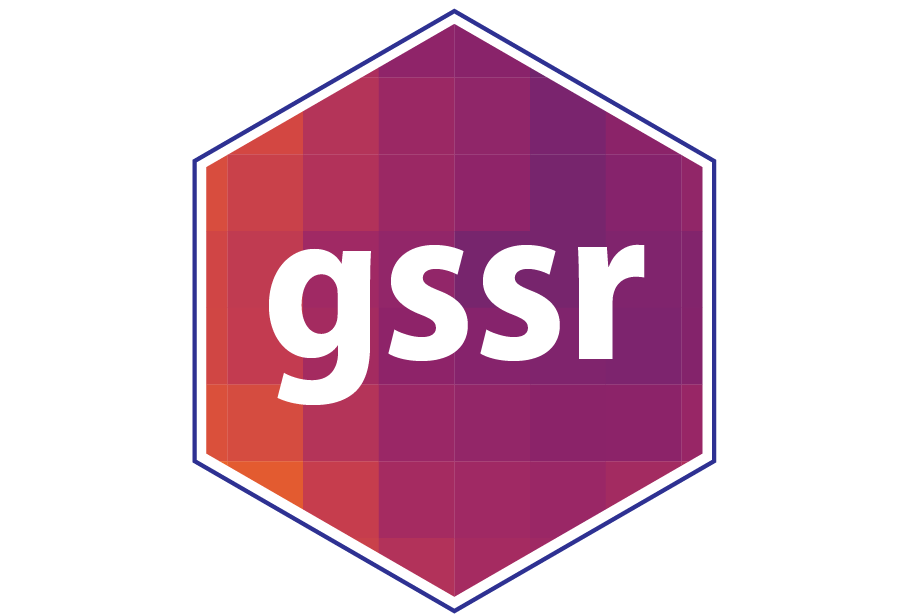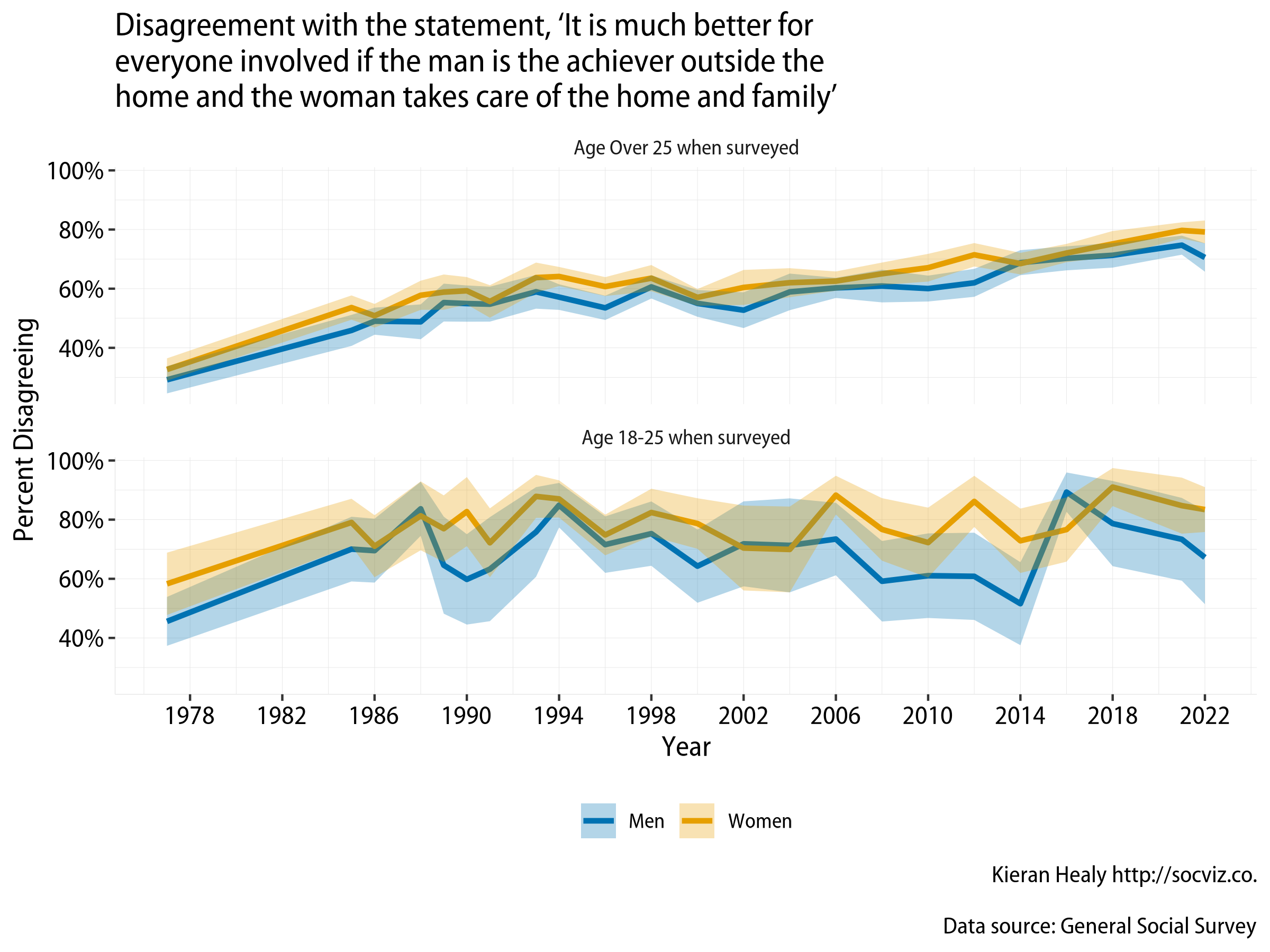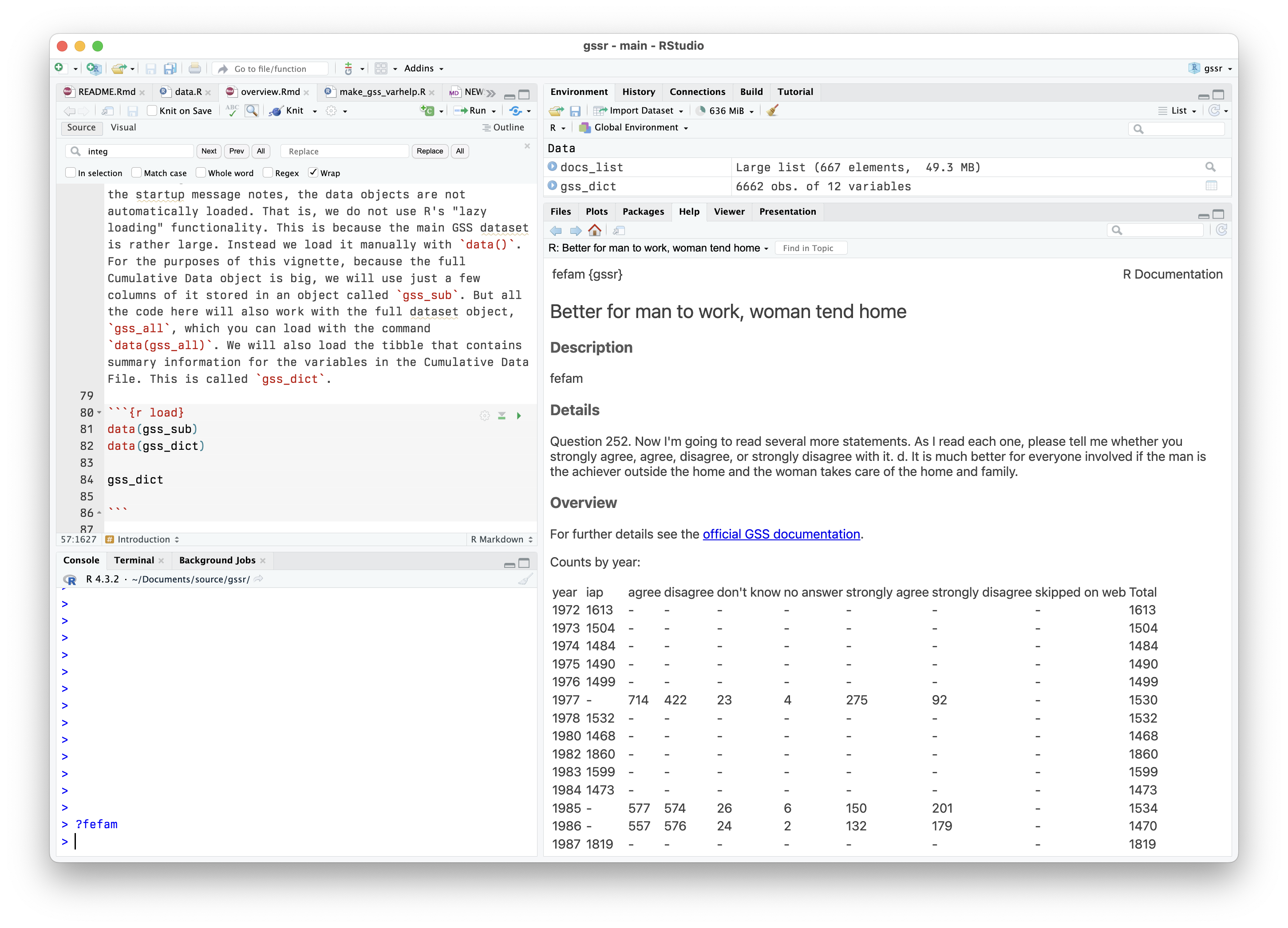The General Social Survey Cumulative Data (1972-2022, release 2a) and
Panel Data files packaged for easy use in R. The companion package to
{gssr} is gssrdoc, which
integrates the GSS codebook into R’s help system. I recommend you
install both packages.
{gssr} is a data package, bundling several datasets into a convenient
format. The relatively large size of the data in the package means it is
not suitable for hosting on CRAN, the
core R package repository. The same is true of {gssrdoc}.
My R Universe provides binary
packages for {gssr} and {gssrdoc}. To install both packages, copy
and paste the following code to the R console:
# Install 'gssr' from 'ropensci' universe
install.packages('gssr', repos =
c('https://kjhealy.r-universe.dev', 'https://cloud.r-project.org'))
# Also recommended: install 'gssrdoc' as well
install.packages('gssrdoc', repos =
c('https://kjhealy.r-universe.dev', 'https://cloud.r-project.org'))Because the packages have dependencies that are on CRAN, we add CRAN as
well as the R Universe to the repos argument.
The binary packages will install noticeably quicker than building the
package from source. Plus, you can use install.packages() directly.
You can also install gssr from GitHub with:
remotes::install_github("kjhealy/gssr")library(gssr)
#> Package loaded. To attach the GSS data, type data(gss_all) at the console.
#> For the codebook, type data(gss_dict).
#> For the panel data and documentation, type e.g. data(gss_panel08_long) and data(gss_panel_doc).
#> For help on a specific GSS variable, type ?varname at the console.You can get the data for any single GSS year by using gss_get_yr() to
download it from NORC and put it directly into a tibble.
gss18 <- gss_get_yr(2018)
#> Fetching: https://gss.norc.org/documents/stata/2018_stata.zip
gss18
#> # A tibble: 2,348 × 1,069
#> year id wrkstat hrs1 hrs2 evwork wrkslf wrkgovt
#> <dbl+lbl> <dbl> <dbl+lbl> <dbl+lbl> <dbl+lbl> <dbl+lbl> <dbl+l> <dbl+l>
#> 1 2018 1 3 [with … NA(i) [iap] 41 NA(i) [iap] 2 [som… 2 [pri…
#> 2 2018 2 5 [retir… NA(i) [iap] NA(i) [iap] 1 [yes] 2 [som… 2 [pri…
#> 3 2018 3 1 [worki… 40 NA(i) [iap] NA(i) [iap] 2 [som… 2 [pri…
#> 4 2018 4 1 [worki… 40 NA(i) [iap] NA(i) [iap] 2 [som… 2 [pri…
#> 5 2018 5 5 [retir… NA(i) [iap] NA(i) [iap] 1 [yes] 2 [som… 2 [pri…
#> 6 2018 6 5 [retir… NA(i) [iap] NA(i) [iap] 1 [yes] 2 [som… 2 [pri…
#> 7 2018 7 1 [worki… 35 NA(i) [iap] NA(i) [iap] 2 [som… 1 [gov…
#> 8 2018 8 1 [worki… 89 [89+… NA(i) [iap] NA(i) [iap] 2 [som… 2 [pri…
#> 9 2018 9 1 [worki… 40 NA(i) [iap] NA(i) [iap] 1 [sel… 2 [pri…
#> 10 2018 10 1 [worki… 40 NA(i) [iap] NA(i) [iap] 2 [som… 2 [pri…
#> # ℹ 2,338 more rows
#> # ℹ 1,061 more variables: occ10 <dbl+lbl>, prestg10 <dbl+lbl>,
#> # prestg105plus <dbl+lbl>, indus10 <dbl+lbl>, marital <dbl+lbl>,
#> # martype <dbl+lbl>, divorce <dbl+lbl>, widowed <dbl+lbl>,
#> # spwrksta <dbl+lbl>, sphrs1 <dbl+lbl>, sphrs2 <dbl+lbl>, spevwork <dbl+lbl>,
#> # cowrksta <dbl+lbl>, cowrkslf <dbl+lbl>, coevwork <dbl+lbl>,
#> # cohrs1 <dbl+lbl>, cohrs2 <dbl+lbl>, spwrkslf <dbl+lbl>, …The GSS cumulative data file is large. It is included ingssr but not
loaded by default when you invoke the package. (That is, gssr does not
use R’s “lazy loading” facility. The data file is too big to do this
without error.) To load it (or the other) datasets, first load the
library and then use data() to make the data available. For example,
load the cumulative GSS file like this:
data(gss_all)This will take a moment. Once it is ready, the gss_all object is
available to use in the usual way:
gss_all
#> # A tibble: 72,390 × 6,694
#> year id wrkstat hrs1 hrs2 evwork occ prestige
#> <dbl+lbl> <dbl> <dbl+lbl> <dbl+lbl> <dbl+lbl> <dbl+lbl> <dbl> <dbl+lb>
#> 1 1972 1 1 [workin… NA(i) [iap] NA(i) [iap] NA(i) [iap] 205 50
#> 2 1972 2 5 [retire… NA(i) [iap] NA(i) [iap] 1 [yes] 441 45
#> 3 1972 3 2 [workin… NA(i) [iap] NA(i) [iap] NA(i) [iap] 270 44
#> 4 1972 4 1 [workin… NA(i) [iap] NA(i) [iap] NA(i) [iap] 1 57
#> 5 1972 5 7 [keepin… NA(i) [iap] NA(i) [iap] 1 [yes] 385 40
#> 6 1972 6 1 [workin… NA(i) [iap] NA(i) [iap] NA(i) [iap] 281 49
#> 7 1972 7 1 [workin… NA(i) [iap] NA(i) [iap] NA(i) [iap] 522 41
#> 8 1972 8 1 [workin… NA(i) [iap] NA(i) [iap] NA(i) [iap] 314 36
#> 9 1972 9 2 [workin… NA(i) [iap] NA(i) [iap] NA(i) [iap] 912 26
#> 10 1972 10 1 [workin… NA(i) [iap] NA(i) [iap] NA(i) [iap] 984 18
#> # ℹ 72,380 more rows
#> # ℹ 6,686 more variables: wrkslf <dbl+lbl>, wrkgovt <dbl+lbl>,
#> # commute <dbl+lbl>, industry <dbl+lbl>, occ80 <dbl+lbl>, prestg80 <dbl+lbl>,
#> # indus80 <dbl+lbl>, indus07 <dbl+lbl>, occonet <dbl+lbl>, found <dbl+lbl>,
#> # occ10 <dbl+lbl>, occindv <dbl+lbl>, occstatus <dbl+lbl>, occtag <dbl+lbl>,
#> # prestg10 <dbl+lbl>, prestg105plus <dbl+lbl>, indus10 <dbl+lbl>,
#> # indstatus <dbl+lbl>, indtag <dbl+lbl>, marital <dbl+lbl>, …{gssr}’s companion package,
gssrdoc provides documentation for
all GSS variables in the cumulative data file via R’s help system. You
can browse variables by name in the package’s help file or type ?
followed by the name of the variable at the console to get a standard R
help page containing information on the variable, the values it takes
and (in most cases) a crosstabulation of the variable’s values for each
year of the GSS. This facility is particularly convenient in an IDE such
as RStudio or Microsoft Visual Studio.
We often want to know which years a question or group of questions was
asked. We can find this out for one or more variables with
gss_which_years().
gss_which_years(gss_all, fefam)
#> # A tibble: 33 x 2
#> year fefam
#> <dbl> <lgl>
#> 1 1972 FALSE
#> 2 1973 FALSE
#> 3 1974 FALSE
#> 4 1975 FALSE
#> 5 1976 FALSE
#> 6 1977 TRUE
#> 7 1978 FALSE
#> 8 1980 FALSE
#> 9 1982 FALSE
#> 10 1983 FALSE
#> # … with 24 more rows
When querying more than one variable, use c():
gss_all |>
gss_which_years(c(industry, indus80, wrkgovt, commute)) |>
print(n = Inf)
## # A tibble: 34 × 5
## year industry indus80 wrkgovt commute
## <dbl+lbl> <lgl> <lgl> <lgl> <lgl>
## 1 1972 TRUE FALSE FALSE FALSE
## 2 1973 TRUE FALSE FALSE FALSE
## 3 1974 TRUE FALSE FALSE FALSE
## 4 1975 TRUE FALSE FALSE FALSE
## 5 1976 TRUE FALSE FALSE FALSE
## 6 1977 TRUE FALSE FALSE FALSE
## 7 1978 TRUE FALSE FALSE FALSE
## 8 1980 TRUE FALSE FALSE FALSE
## 9 1982 TRUE FALSE FALSE FALSE
## 10 1983 TRUE FALSE FALSE FALSE
## 11 1984 TRUE FALSE FALSE FALSE
## 12 1985 TRUE FALSE TRUE FALSE
## 13 1986 TRUE FALSE TRUE TRUE
## 14 1987 TRUE FALSE FALSE FALSE
## 15 1988 TRUE TRUE FALSE FALSE
## 16 1989 TRUE TRUE FALSE FALSE
## 17 1990 TRUE TRUE FALSE FALSE
## 18 1991 FALSE TRUE FALSE FALSE
## 19 1993 FALSE TRUE FALSE FALSE
## 20 1994 FALSE TRUE FALSE FALSE
## 21 1996 FALSE TRUE FALSE FALSE
## 22 1998 FALSE TRUE FALSE FALSE
## 23 2000 FALSE TRUE TRUE FALSE
## 24 2002 FALSE TRUE TRUE FALSE
## 25 2004 FALSE TRUE TRUE FALSE
## 26 2006 FALSE TRUE TRUE FALSE
## 27 2008 FALSE TRUE TRUE FALSE
## 28 2010 FALSE TRUE TRUE FALSE
## 29 2012 FALSE FALSE TRUE FALSE
## 30 2014 FALSE FALSE TRUE FALSE
## 31 2016 FALSE FALSE TRUE FALSE
## 32 2018 FALSE FALSE TRUE FALSE
## 33 2021 FALSE FALSE FALSE FALSE
## 34 2022 FALSE FALSE FALSE FALSE In addition to the Cumulative Data File, the gssr package also includes
the GSS’s panel data. The current rotating panel design began in 2006. A
panel of respondents were interviewed that year and followed up on for
further interviews in 2008 and 2010. A second panel was interviewed
beginning in 2008, and was followed up on for further interviews in 2010
and 2012. And a third panel began in 2010, with follow-up interviews in
2012 and 2014. The gssr package provides three datasets, one for each
of three-wave panels. They are gss_panel06_long, gss_panel08_long,
and gss_panel10_long. The datasets are provided by the GSS in wide
format but (as their names suggest) they are packaged here in long
format. The 2020 panel is an exception to this, for reasons described
below. The conversion was carried out using the panelr
package and its long_panel() function.
Conversion from long back to wide format is possible with the tools
provided in panelr.
The panel data objects must be loaded in the same way as the cumulative
data file, using data().
data("gss_panel06_long")
gss_panel06_long
#> # A tibble: 6,000 × 1,572
#> firstid ballot form formwt oversamp sampcode sample samptype vstrat vpsu
#> <fct> <fct> <fct> <dbl> <dbl> <fct> <fct> <fct> <dbl> <dbl>
#> 1 0009 Ballot c Alter… 1 1 501 2000 … 2006 Sa… 1957 2
#> 2 0009 Ballot c Alter… 1 1 501 2000 … 2006 Sa… 1957 2
#> 3 0009 Ballot c Alter… 1 1 501 2000 … 2006 Sa… 1957 2
#> 4 0010 Ballot a Stand… 1 1 501 2000 … 2006 Sa… 1957 2
#> 5 0010 Ballot a Stand… 1 1 501 2000 … 2006 Sa… 1957 2
#> 6 0010 Ballot a Stand… 1 1 501 2000 … 2006 Sa… 1957 2
#> 7 0011 Ballot c Alter… 1 1 501 2000 … 2006 Sa… 1957 2
#> 8 0011 Ballot c Alter… 1 1 501 2000 … 2006 Sa… 1957 2
#> 9 0011 Ballot c Alter… 1 1 501 2000 … 2006 Sa… 1957 2
#> 10 0012 Ballot a Alter… 1 1 501 2000 … 2006 Sa… 1958 1
#> # ℹ 5,990 more rows
#> # ℹ 1,562 more variables: wtpan12 <dbl>, wtpan123 <dbl>, wtpannr12 <dbl>,
#> # wtpannr123 <dbl>, letin1a <fct>, wave <dbl>, abany <fct>, abdefect <fct>,
#> # abhlth <fct>, abnomore <fct>, abpoor <fct>, abrape <fct>, absingle <fct>,
#> # accntsci <fct>, acqasian <fct>, acqattnd <fct>, acqblack <fct>,
#> # acqbrnda <fct>, acqchild <fct>, acqcohab <fct>, acqcon <fct>,
#> # acqcops <fct>, acqdems <fct>, acqelecs <fct>, acqfmasn <fct>, …Panel data objects are regular tibbles. You do not need to use panelr
to work with the data.
The column names in long format do not have wave identifiers. Rather,
firstid and wave variables track the cases. The firstid variable
is unique for every respondent in the panel and has no missing values.
The wave variable indexes responses from a given firstid panelist in
each wave (if observed). The id variable is from the GSS and indexes
individuals within waves.
data("gss_panel08_long")
gss_panel08_long |>
select(firstid, wave, id, sex)
#> # A tibble: 6,069 × 4
#> firstid wave id sex
#> <fct> <dbl> <fct> <fct>
#> 1 0001 1 1 Male
#> 2 0001 2 8001 Male
#> 3 0001 3 <NA> <NA>
#> 4 0002 1 2 Male
#> 5 0002 2 8002 Male
#> 6 0002 3 8001 Male
#> 7 0003 1 3 Male
#> 8 0003 2 8003 Male
#> 9 0003 3 8002 Male
#> 10 0004 1 4 Male
#> # ℹ 6,059 more rowsWe can look at attrition across waves with, e.g.:
gss_panel06_long |>
select(wave, id) |>
group_by(wave) |>
summarize(observed = n_distinct(id),
missing = sum(is.na(id)))
#> # A tibble: 3 × 3
#> wave observed missing
#> <dbl> <int> <int>
#> 1 1 2000 0
#> 2 2 1537 464
#> 3 3 1277 724The COVID-19 pandemic also affected the panel data design. In 2020, the
GSS was run as two studies; namely, (1) a panel re-interview of past
respondents from the 2016 and 2018 cross sectional GSS studies (referred
to as the 2016-2020 GSS Panel), and (2) an independent fresh
cross-sectional address-based sampling push to web study (referred to as
2020 cross-sectional survey). The gssr package provides the data for
the first study as gss_panel20. This study empaneled former 2016 and
2018 GSS respondents to answer a GSS questionnaire in 2020 (i.e., the
2016-2020 GSS panel). In the 2016-2020 GSS Panel, variables only contain
data from one of the three years. To differentiate between versions of
each variable, they have been appended with suffixes. Variables from
2016 (Wave 1a) have _1a appended, variables from 2018 (Wave 1b) have
_1b appended, and variables from 2020 (Wave 2) have _2 appended.
Users can also track cases from 2016 and 2018, and reinterviews from
2020 with the variable samptype.
data("gss_panel20")
gss_panel20
#> # A tibble: 5,215 × 4,296
#> samptype yearid fileversion panstat wtssall_1a wtssall_1b wtssall_2
#> <dbl+lbl> <chr> <chr> <dbl+l> <dbl> <dbl> <dbl>
#> 1 2016 [sample from… 20160… GSS 2020 P… 1 [sel… 0.957 NA 1.09
#> 2 2016 [sample from… 20160… GSS 2020 P… 1 [sel… 0.478 NA 0.543
#> 3 2016 [sample from… 20160… GSS 2020 P… 0 [not… 0.957 NA NA
#> 4 2016 [sample from… 20160… GSS 2020 P… 1 [sel… 1.91 NA 2.17
#> 5 2016 [sample from… 20160… GSS 2020 P… 0 [not… 1.44 NA NA
#> 6 2016 [sample from… 20160… GSS 2020 P… 2 [sel… 0.957 NA NA
#> 7 2016 [sample from… 20160… GSS 2020 P… 0 [not… 1.44 NA NA
#> 8 2016 [sample from… 20160… GSS 2020 P… 1 [sel… 0.957 NA 1.09
#> 9 2016 [sample from… 20160… GSS 2020 P… 1 [sel… 0.957 NA 1.09
#> 10 2016 [sample from… 20160… GSS 2020 P… 0 [not… 0.957 NA NA
#> # ℹ 5,205 more rows
#> # ℹ 4,289 more variables: wtssnr_1a <dbl>, wtssnr_1b <dbl>, wtssnr_2 <dbl>,
#> # vstrat_1a <dbl>, vstrat_1b <dbl>, vstrat_2 <dbl>, vpsu_1a <dbl>,
#> # vpsu_1b <dbl>, vpsu_2 <dbl>, year_1a <int>, year_1b <int>, year_2 <int>,
#> # id_1a <dbl>, id_1b <dbl>, id_2 <dbl>, mar1_1a <dbl+lbl>, mar2_1a <dbl+lbl>,
#> # mar3_1a <dbl+lbl>, mar4_1a <dbl+lbl>, mar5_1a <dbl+lbl>, mar6_1a <dbl+lbl>,
#> # mar7_1a <dbl+lbl>, mar8_1a <dbl+lbl>, mar9_1a <dbl+lbl>, …Unlike the other panels, these data are provided in wide format. Users are strongly encouraged to read the official documentation at the NORC website.
The GSS administrators have released a Methodological Primer along with the Documentation and Codebook for the 2021 survey that users should read carefully in connection with the effects of COVID-19 on data collection for the GSS.
The Primer notes:
Since its inception, the GSS has conducted data collection via in-person interviews as its primary mode of data collection. The pandemic forced the GSS to change this design, moving from in-person to address- based sampling and a push-to-web methodology, with the bulk of the interview conducted online via a self- administered questionnaire.
In addition,
We recommend our users include the one of the following statements when reporting on the GSS 2021 Cross-section data: Total Survey Error Summary Perspective for the 2021 GSS Cross-section: Changes in opinions, attitudes, and behaviors observed in 2021 relative to historical trends may be due to actual change in concept over time and/or may have resulted from methodological changes made to the survey methodology during the COVID-19 global pandemic.
And,
Suggested Statement to Include in Articles and Reports That Use GSS Data: To safeguard the health of staff and respondents during the COVID-19 pandemic, the 2021 GSS data collection used a mail-to-web methodology instead of its traditional in-person interviews. Research and interpretation done using the data should take extra care to ensure the analysis reflects actual changes in public opinion and is not unduly influenced by the change in data collection methods. For more information on the 2021 GSS methodology and its implications, please visit https://gss.norc.org/Get-The-Data
The package is documented at http://kjhealy.github.io/gssr/. The GSS
homepage is at http://gss.norc.org/. While the gssr package
incorporates the publicly-available GSS cumulative data file, this
package is not associated with or endorsed by the National Opinion
Research Center or the General Social Survey.


